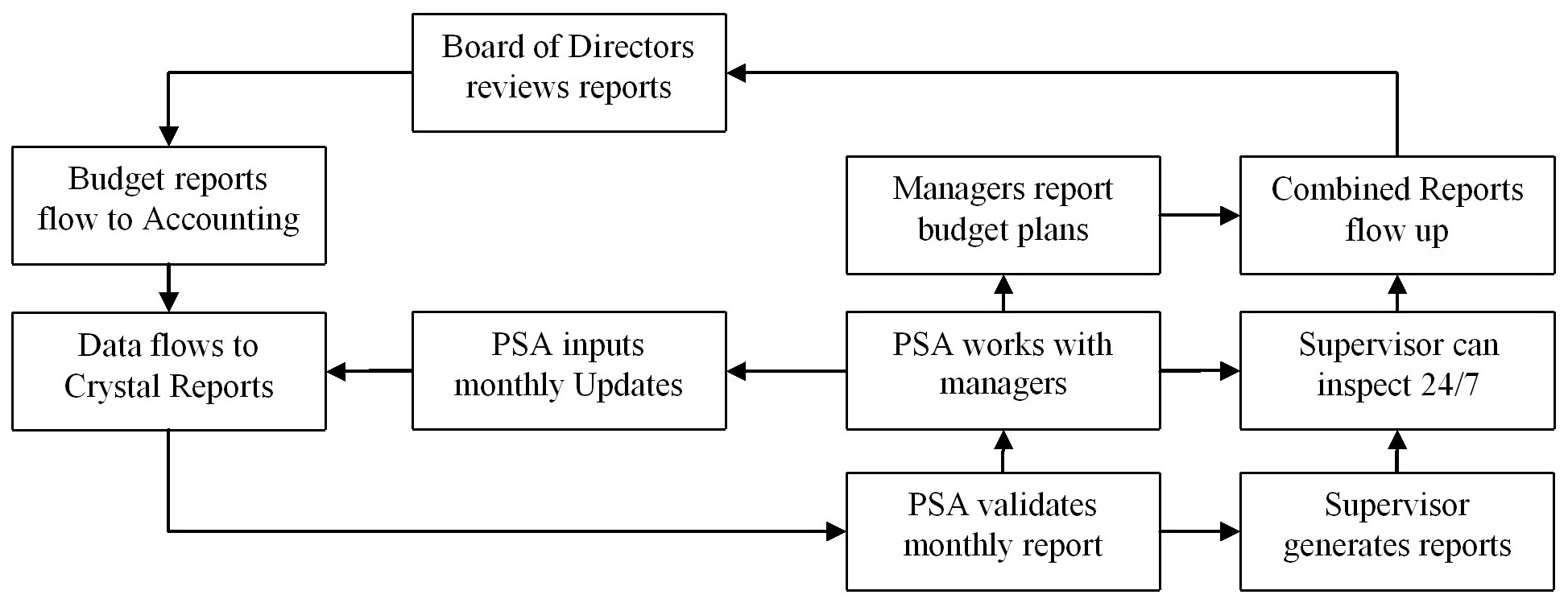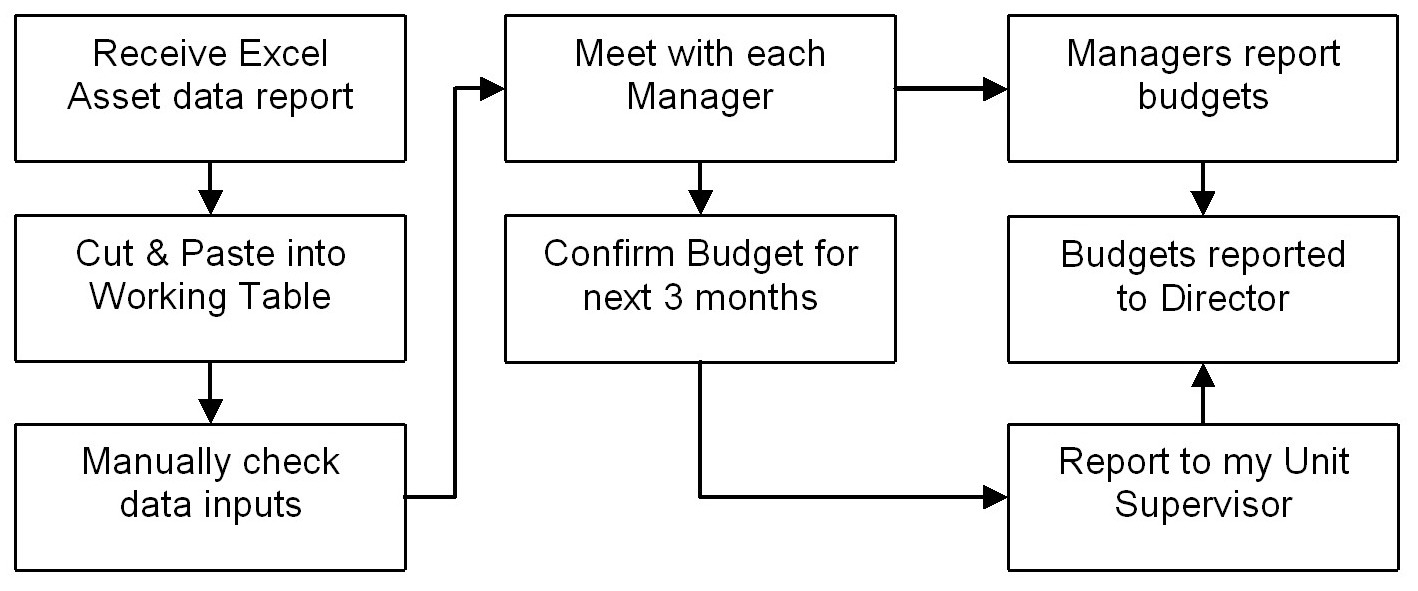 SUMMARY
SUMMARY
9 Monthly Budgets brought back to Plan
First to notice a tiny "data pattern" clue
Resolving the issue by unearthing 100+ computers / printers
Collapsing unwieldy politicized bottlenecks within 2 Months
"Data inspect/correct rework" tasks, and "Rolling budget adjustments" scrapped
Delivering 8 monthly reports early vs. the practice of 3 months late
Bringing monthly combined budget back to plan
5 positions reassigned during Phase 3
'Budget Check' Process
Project Management Offfice (PMO) manages software changes and upgrades
PMO provides software sub-contract programming services to other corporate units
One of my Project Support Analyst (PSA) tasks was to monitor 800-1,400 monthly computer cost transfers
Receiving data inflows, checking data, reporting to eight managers and PMO unit supervisor
Final Revised Process

BACKGROUND BUSINESS PAIN
Three Months Late Reporting - Accepted Standard Practice
Each consultant uses a computer, and each asset has a cost
Costs shift between 8-10 budgets every month, alongside the consultants that they are tied to
My responsibility was to receive, collate and report the cost shifts for 800-1,400 assets
Using Excel spreadsheets, well before each manager’s budget due date
Reporting three months late had been accepted practice for 5 years
...and managers had stopped asking for deliverables by deadline.
Challenges
Internal Process - "As Is"
Cut & Paste inflowing excel data to master excel worksheet.
Tabulate all reports on master sheet, meet with 8 managers twice, report pre-budget costs
Consult to determine which consultants are going where, submit validation to supervisor
Ignore discrepancies as supervisor requests budget rollovers each month
Upload update to master monthly doublecheck report, which goes to division Director

Internal Culture
The data that I received every month was inaccurate; and no one knew why
Culture did not support taking initiative to find out why
The unit dealt with discrepancies with rolling monthly budget adjustment
Extremely difficult to deliver accurate reports by the official deadline
The practice was to ignore the official deadline as rollover practice worked
Reporting creep had created a 3-month accuracy gap which had become accepted practice for 5 years
INVESTIGATIVE ACTIONS
Investigative Action #1
Took Initiative
While reporting to the accepted practice, noticed oddities in the in-flowing asset data
Investigated the data inflows, discovering that my sub-task process had never been mapped
Result
Discovering that asset descriptions had never been updated when new types were purchased.
Reformulating and re-designing the worksheet unearthed the misplaced costs
High-Level View of "As Is" Workflow

Upgraded Process
Using this, we brought all eight budgets back to plan.
Receive reports - Transcribe data from inflowing excel sheet to master excel worksheet
Tabulate all reports to corrected master sheet
Meet 8 managers each once one month prior to manager's reporting deadline
If needed, deal with minimal discrepancies with a second check-in meeting
High-Level View of Revised Workflow

Investigative Action #2
Forensic study of original workflow
The master process had never been mapped, so followed up with this
Thoroughly mapping “As Is” procedure by interviewing data holders and forensically following data threads
Figuring out how the errors had originally crept in...
High-Level View of "As Is" 5-Process Workflow

Investigative Action #3
Following the tangled data flow threads
By analyzing the threads, determining how the tangle increased error-making
Proposing to collapse the web of tangled data workflows:
By consolidating five positions into one role:
Making the PSA (the “final reporting person”) responsible for original input quality
Tying reward structure to data input quality
Selling the Change
Working the objections, selling the change to managers
Showing how recognizing and addressing process not previously recognized as antiquated . . .
(1) Builds a better team by forthrightly addressing a "wicked problem" in the company
(2) Creates career growth opportunities for staff in 5 units
(3) Cuts significant re-work and tangles out of the process
Impact
Five Manual Sub-processes consolidated into One efficient automated workflow
Management evaluated the proposed process changes
Managers grew the change to an automated new Crystal Reports project
Assigning a project manager (PM) to automate the workflow and data quality checking
PM offering compliments, saying I had ‘saved her months of mapping work’
PMO’s ability to provide budget-advice to our manager-customers improved
Accounting rework stopped; Reporting became timely and therefore useful
After Crystal Reports tool went live, staff in five units shifted to new responsibilities
High-Level View of Crystal Reports Workflow

SUBSEQUENT PROJECT WORK
Selected to Redesign Unit's Excel Master Budgeting Spreadsheets
PSA Work Unit - High-level view of Workflow
Each PSA monitors a large number of software projects
Working with contract Project Managers while monitoring compliance to finance policies
For me, at any one time, monitoring up to 11 projects budgeted at $75,000 to $8 million
Six PSAs and Supervisor, cutting-and-pasting finance data into Working Spreadsheets
Cutting-and-pasting collated Working Spreadsheet results to master reporting worksheets
Background to Upgrade
Working Spreadsheets had grown complex and unwieldy over the years
With monthly equation changes creating conflicting instructions, significant rework and rechecking
Inadvertently creating danger of errors in public funds' reporting
Many of our contract Project Managers had stopped using the PSA-level worksheets
Out of frustration, creating their own project budgeting spreadsheet tools . . .
Since at the end-of-the-day, all data got cut-&-pasted into upper reports anyway
But these issues extended to upper Reports
Example:
A cell holding a reporting sum in our level of reporting was coloured purple
This referred to a specific cost summary flowing from a policy instruction
This data was collated into a higher level purple-coloured summary report cell
But in that upper cell, the reported data was used to report to an exactly opposite summary
Many inconsistencies of this nature flowed through the reports
All data ultimately flowed to the Board for Budget Review
Prior to being selected
Took the initiative to address the issues at my level of reporting:
Redesigning a sample top-level summary worksheet used at my level
: Interviewing team members and project managers
: Throughly mapping PSA budget monitoring process from scratch
: Reviewing intent of colour usage in the "As Is" template
: Creating mini-changes (mini "agile sprints") to test rolling changes
Focusing on Ease of Navigation to improve accuracy and cut rework:
(1) Naturallness of Workflow
(2) Minimizing colours/ensuring consistent use as tool cues
(3) Matching visual workflow to actual steps in reporting workflow
With final redesign proposal, patterning the worksheet to ensure:
(1) Accuracy of Budget Reporting
(2) Removing monthly "new remembering" challenges
(3) Removing the need for constant busywork and rework costs
Subsequently
Being Selected to Redesign our Workheets to "Make them look Pretty"
"Pretty" meant that I had achieved my design goal
Producing an intuitive Naturallness of Navigation for complex data reporting
: Creating a useful combination of minimized colour use, cueing, and navigation flow
: Visual design cueing user to match actions to actual steps of our data entry/checking process
This result flows out of the Design Thinking process of "Form Equals Function"
Where "Pleasing to the Eye" is produced to satisfy a business need
: Step-by-Step Navigation along a consistent path vs. back-and-forth, up-and-down checking
: Intuitive ease-of-use, readability, upgradability, and minimizing rework
: Removing need for constant worksheet design re-checks and corrections
: All future equation changes easy to implement without significant time and rework cost
: Similar in practice to the use of web design "CSS3 url calling" to cut bandwidth and content change costs